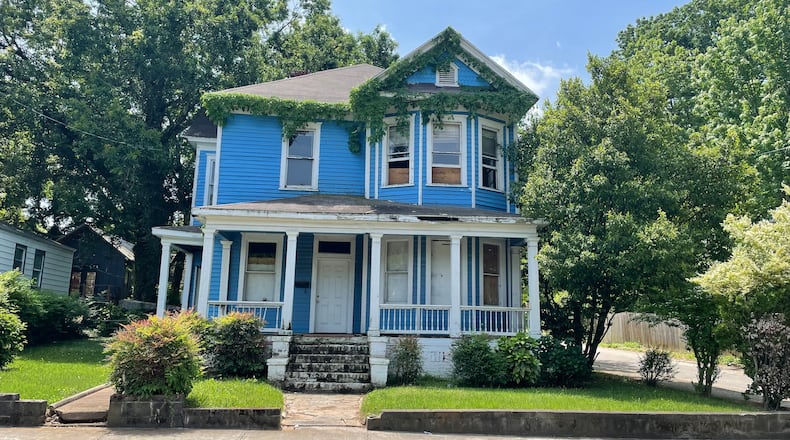Farrow Allen hadn’t seen the exterior of his late grandfather’s home in more than a decade.
Earlier this week, he and his wife climbed the brick stairs of the Folk Victorian in South Atlanta and entered the home where Allen’s mother had been raised.
“It is a total adventure. I can’t imagine what it was like before. It is the first time I have ever been in it,” said Allen who was visiting Atlanta for a remembrance of the 1906 Atlanta Race Massacre during which thousands of white Atlantans terrorized and murdered residents of Black neighborhoods including South Atlanta. Allen’s grandfather, Luther Judson Price, was a store owner and postmaster who lived and worked in the neighborhood.
When Allen had last seen the home 15 years ago, it had fallen into disrepair, he said. It might have been torn down and built over, its history forever lost, had it not been purchased seven years ago by Kysha and Jonathan Hehn.
In April, when the couple decided to restore the house, its history seemed to come alive, said Kysha Hehn. The project, which is being documented by “This Old House” for the new season airing Sept. 29, has been grounding and nurturing, she said, allowing the Hehns and their two children, Alivia Sage and Joia, to connect with people in the community and beyond in ways they never could have anticipated.
Moments like these are quickly becoming an anomaly in certain Atlanta neighborhoods due to current real estate trends. At the end of 2021, almost 43% of all single family home sales in metro Atlanta were acquired by investors who purchase homes and rent them at high costs, according to real estate research firm CoreLogic.
In June, Atlanta Mayor Andre Dickens told Bloomberg he wanted to place restrictions on property investors, but rising costs are just one concern. Preserving the character and history of communities also requires a certain rootedness and desire to make connections between the past and present.
“The natural transition is for the house to be a place of holding memory and preserving legacy. That is a responsibility that we hold,” Kysha Hehn told me when I visited her home recently.
Credit: Nedra Rhone
Credit: Nedra Rhone
Established in the late 1880s, the community of South Atlanta was also home to two historically Black institutions, Clark University and Gammon Theological Seminary, that helped anchor the neighborhood.
Price, who was born into slavery on a Georgia plantation, was drawn to the area after emancipation to attend Clark University. Allen’s mother was the youngest of the Price children but she recalled and shared stories of family gatherings at the house with church members, Black masons and other community members as well as her parent’s dedication to civil rights and voting advocacy.
On Sept. 22, 1906, riled by inflammatory headlines in newspapers, including the Atlanta Journal and the Atlanta Constitution, white mobs terrorized Black neighborhoods across the city destroying businesses and randomly attacking Black citizens. At least 25 Black residents and two white residents died.
Price was accused of illegally providing ammunition to his neighbors in South Atlanta to fend off their attackers. He was held at the Fulton County Jail until the massacre ended. In the aftermath, a multiracial coalition of citizens met to determine how to help those most in need, according to the Fulton County Remembrance Coalition.
Much of that history had been lost. Atlanta did not publicly recognize the massacre until 2006. Even within the Price family there was limited information, Allen said. Price’s children grew up and dispersed to points north including New York City and Chicago. In the 1930s, the family home was sold to another local family who held it until the 1990s when it became uninhabitable.
Over the years, the home has come alive during the anniversary of the massacre, when Atlanta residents take part in remembrance events that feature tours of the neighborhood and nearby South-View Cemetery, dinners and a procession through South Atlanta. This year’s events will also include the dedication of markers in Sweet Auburn, East Point’s Sumner Park and South Atlanta, that commemorate the massacre and honor those killed.
Upon meeting the Hehns, Allen presented them with other pieces of history: his mother’s written account of the massacre and the original postal scale his grandfather used as postmaster.
“We have no one to pass anything on to,” Allen said. “They are continuing our legacy. If it were not for them, this place would be gone.”
The Hehns have plans to continue incorporating the legacy of the Price family into the home, leaving original details like built-in drawers, fireplaces, and picture rails inside the home as well as surprises they have found along the way, including a newspaper from the mid-1900s nestled inside an oven and exposed wood revealed in the door jambs.
In the front-facing rooms, where the Price family likely entertained, the Hehns chose custom Sankofa-themed wallpaper by Forbes and Masters symbolizing the importance of allowing the past to serve as a guide for the future.
Kysha Hehn said she hopes the rooms will soon host legacy residents, young children and the students who walk past the house each day on the way to the same school campus that Luther Price once walked.
“This is a community home because of what they have shared and how they have welcomed us,” she said.
Read more on the Real Life blog (ajc.com/opinion/real-life-blog/) and find Nedra on Facebook (facebook.com/AJCRealLifeColumn) and Twitter (@nrhoneajc) or email her at nedra.rhone@ajc.com.
About the Author
Keep Reading
The Latest
Featured





